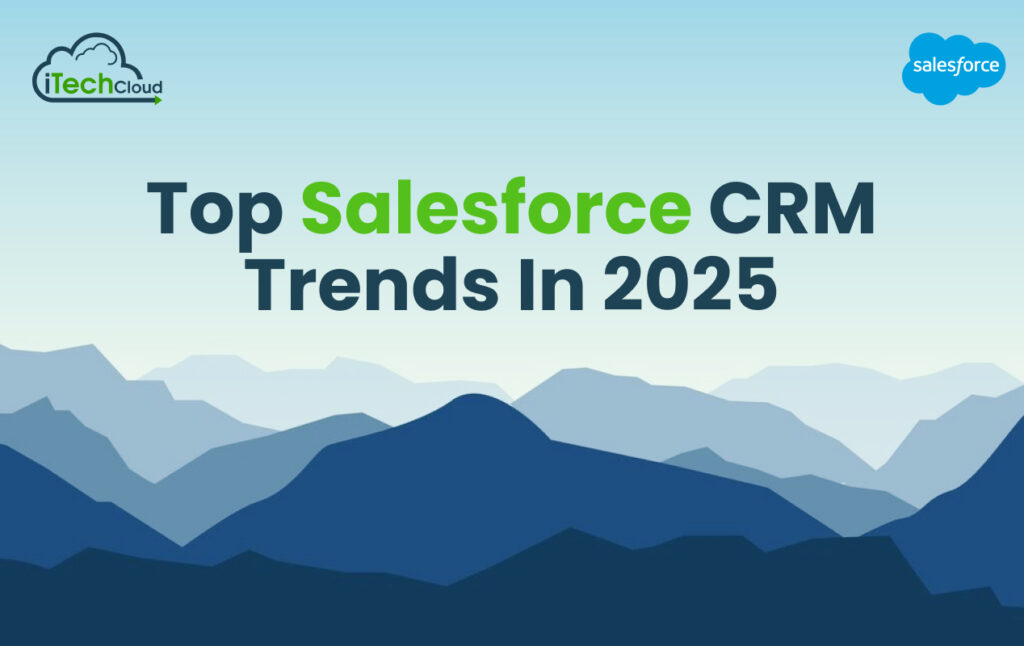Top Salesforce CRM Trends in 2025

Salesforce continues to revolutionize the way businesses manage customer relationships and streamline operations. As we approach 2025, emerging trends are reshaping the Salesforce ecosystem, driven by advancements in technology, changing business needs, and increasing customer expectations.
In this article, we delve into the top Salesforce CRM trends in 2025.
Table of Contents
1. AI Integration with Einstein GPT
Artificial Intelligence (AI) is at the forefront of Salesforce’s innovations, and Einstein GPT is taking CRM capabilities to the next level. With enhanced predictive analytics, automated customer service responses, and real-time data insights, Einstein GPT is enabling businesses to deliver hyper-personalized experiences. Companies are leveraging AI to predict customer needs, optimize sales pipelines, and improve marketing ROI.
2. Industry-Specific CRM Solutions
Salesforce is increasingly offering tailored solutions for industries like healthcare, retail, manufacturing, and financial services. These industry-specific clouds come preloaded with features and templates designed to address unique challenges. For example, Salesforce Health Cloud provides tools for patient engagement, while Financial Services Cloud enhances client relationship management.
3. The Rise of Hyper-Automation
Hyper-automation combines AI, machine learning, and robotic process automation (RPA) to streamline workflows. Salesforce’s tools, like Flow Orchestrator and MuleSoft, are driving this trend by automating repetitive tasks, reducing manual effort, and improving operational efficiency. Businesses are adopting hyper-automation to improve employee productivity and reduce errors.
4. Expanded Use of Customer Data Platforms (CDPs)
Salesforce’s Customer Data Platform (CDP) is becoming essential for companies seeking a unified view of their customers. By integrating data from multiple sources, Salesforce CDP helps organizations understand customer behavior, predict trends, and deliver personalized marketing campaigns. In 2025, businesses will increasingly rely on CDPs to gain a competitive edge.
5. Growth of Salesforce AppExchange Ecosystem
The AppExchange marketplace is witnessing exponential growth, with a surge in custom apps and integrations. These third-party solutions cater to specific business needs, allowing companies to extend Salesforce functionality. From advanced analytics tools to niche industry applications, the AppExchange is a hub for innovation.
6. Focus on Sustainability with Net Zero Cloud
Salesforce’s Net Zero Cloud is becoming a pivotal tool for businesses aiming to track and reduce their carbon footprint. This cloud solution enables organizations to monitor emissions, set sustainability goals, and generate transparent reports, aligning with global ESG (Environmental, Social, and Governance) standards.
7. Greater Adoption of Slack for Collaboration
Following Salesforce’s acquisition of Slack, integration between the two platforms has deepened, transforming collaboration across teams. In 2025, businesses are expected to leverage Slack for real-time communication, automated workflows, and seamless integrations with Salesforce, driving productivity and engagement.
8. Composable CRM Architecture
Composable architecture allows businesses to create flexible, customizable CRM solutions using modular components. Salesforce’s composable approach enables organizations to adapt their systems quickly to changing market conditions, providing scalability and agility.
9. Advanced Analytics with Tableau
Tableau, a Salesforce company, is empowering businesses with sophisticated data visualization and analytics. In 2025, organizations will increasingly use Tableau to interpret complex data sets, identify actionable insights, and make data-driven decisions.
10. Strengthening Cybersecurity Measures
Salesforce is enhancing its security features to protect sensitive customer data. Tools like Salesforce Shield and enhanced encryption ensure robust data protection. Compliance with evolving data regulations will remain a top priority in 2025.
11. The Evolution of Mobile-First CRM
Salesforce’s mobile-first approach is gaining traction. Enhanced mobile apps provide on-the-go access to CRM features, enabling sales and service teams to stay productive anytime, anywhere.
12. Emphasis on Customer Experience (CX)
Customer experience continues to be a cornerstone of CRM strategy. Salesforce’s tools, like Service Cloud Voice and personalized marketing journeys, are helping businesses exceed customer expectations. Real-time support, AI-driven chatbots, and proactive service are becoming standard practices.
13. Integration of Blockchain Technology
Blockchain is making its way into Salesforce solutions, particularly in areas like supply chain management and secure transactions. The technology’s transparency and immutability make it ideal for enhancing trust and efficiency.
14. Boosting Sales Efficiency with Revenue Cloud
Revenue Cloud is becoming a vital tool for businesses aiming to optimize their sales processes. By providing end-to-end visibility into the sales cycle, it empowers organizations to identify revenue opportunities, streamline billing, and enhance customer satisfaction.
15. Personalization Through Marketing Cloud Innovations
Marketing Cloud is introducing advanced personalization features, enabling businesses to connect with their audiences on a deeper level. Predictive recommendations, AI-driven campaign optimization, and seamless integration with CDPs are driving impactful marketing strategies.
Conclusion: Salesforce CRM Trends
The Salesforce CRM landscape in 2025 is shaped by technological advancements and evolving customer needs. From AI integration and hyper-automation to sustainability and composable architectures, these trends offer businesses a roadmap to success. By staying ahead of these innovations, organizations can enhance customer satisfaction, improve operational efficiency, and achieve sustainable growth.

